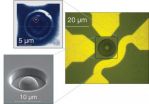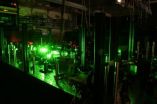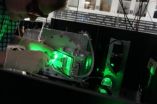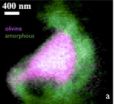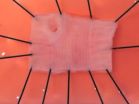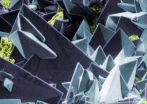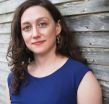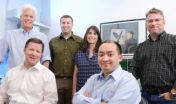(Press-News.org) A team of researchers led by the University of Chicago has developed a technique to record the quantum mechanical behavior of an individual electron contained within a nanoscale defect in diamond. Their technique uses ultrafast pulses of laser light both to control the defect's entire quantum state and observe how that single electron state changes over time. The work appears in this week's online Science Express and will be published in print later this month in Science.
This research contributes to the emerging science of quantum information processing, which demands that science leave behind the unambiguous universe of traditional binary logic—0 or 1—and embrace the counterintuitive quantum world, where behavior is radically different from what humans experience every day. While people are generally content being in one place at a time, electrons can be in many states at once.
The team researches a quantum mechanical property of the electron known as spin. Much like conventional computers use the charge state of electrons to constitute bits of information, a quantum computer would use the spin state of a single electron as its quantum bit, or qubit. The work could accelerate development of quantum computing devices, and the extra computing power that would come with them, because it will be easier to identify materials that have appropriate quantum properties.
The spin system studied is known as the nitrogen-vacancy (NV) center, an atom-sized defect that occurs naturally in diamond, consisting of a nitrogen atom next to a vacant spot in the crystal lattice. "These defects have garnered great interest over the past decade, providing a test-bed system for developing semiconductor quantum bits as well as nanoscale sensors," said team leader David Awschalom, the Liew Family Professor of Molecular Engineering at UChicago. "Here, we were able to harness light to completely control the quantum state of this defect at extremely high speeds."
Quantum snapshots
In this new technique, the researchers locate a single NV center and then illuminate it with a pair of extremely short pulses of laser light. Each pulse lasts less than a picosecond (or a millionth of a millionth of a second). The first pulse excites the quantum states of the defect-bound electron, which then change or evolve in characteristic ways. The second pulse stops that evolution, capturing a picture of the quantum state at that elapsed time.
By progressively extending the elapsed time between the two pulses, the team creates a sequence of quantum-state snapshots—a movie of how the quantum state changes in time. The elapsed time can be as short as femtoseconds (a billionth of a millionth of a second) or as long as nanoseconds (a thousandth of a millionth of a second). On the human scale, this range of time is like the difference between an hour and a century.
Having this vast range of timescales makes the technique especially valuable. The electron is susceptible and interacts with its complex local environment in many different ways, each with a characteristic timescale. Being able to test a wide range of these timescales gives a far more complete picture of the dynamics of the NV center than has been obtained previously.
"Our goal was to push the limits of quantum control in these remarkable defect systems," explained Lee Bassett, co-lead author on the paper and now an assistant professor of electrical and systems engineering at the University of Pennsylvania, "but the technique also provides an exciting new measurement tool. By using pulses of light to direct the defect's quantum dynamics on super-short timescales, we can extract a wealth of information about the defect and its environment."
"It's quite a versatile technique, providing a full picture of the excited state of the quantum defect," said F. Joseph Heremans, a postdoctoral scholar at UChicago, the other co-lead author on the paper. "Previous work on the nitrogen-vacancy center has hinted at some of these processes, but here, simply through the application of these ultrafast pulses, we get a much richer understanding of this quantum beast."
Spin control
It's not just a matter of observation, though. "This technique also provides a means of control of the spin state—an important precursor for any quantum information system," said Evelyn Hu, a professor of applied physics and electrical engineering at Harvard University, who is not connected with the new work.
In addition, the method is not limited to investigating this particular defect. It could be applied to quantum states of matter in a host of materials and technologies, including many semiconductor materials. "You only have to be able to use light to transfer an electron between a ground state and an excited state," said Awschalom.
Professor Guido Burkard, theoretical physicist at the University of Konstanz and a co-author on the paper, remarked, "This technique offers a path toward understanding and controlling new materials at the atomic level."
Hu agrees that the technique opens many new avenues. "Each new system will pose new challenges to understanding the energy levels, local environments, and other properties, but the general approach should provide an enormous step forward for the field," said Hu.
INFORMATION:
In addition to researchers from UChicago's Institute for Molecular Engineering, the team included collaborators at the University of California, Santa Barbara (co-lead author Lee Bassett is now at the University of Pennsylvania), and the University of Konstanz, Germany.
Molecular engineers record an electron's quantum behavior
2014-08-14
ELSE PRESS RELEASES FROM THIS DATE:
Mysteries of space dust revealed
2014-08-14
The first analysis of space dust collected by a special collector onboard NASA's Stardust mission and sent back to Earth for study in 2006 suggests the tiny specks, which likely originated from beyond our solar system, are more complex in composition and structure than previously imagined.
The analysis, completed at a number of facilities including the U.S. Department of Energy's Lawrence Berkeley National Lab (Berkeley Lab) opens a door to studying the origins of the solar system and possibly the origin of life itself.
"Fundamentally, the solar system and everything ...
New Milky Way maps help solve stubborn interstellar material mystery
2014-08-14
An international team of sky scholars, including a key researcher from Johns Hopkins, has produced new maps of the material located between the stars in the Milky Way. The results should move astronomers closer to cracking a stardust puzzle that has vexed them for nearly a century.
The maps and an accompanying journal article appear in the Aug. 15 issue of the journal Science. The researchers say their work demonstrates a new way of uncovering the location and eventually the composition of the interstellar medium—the material found in the vast expanse between star systems ...
CF mucus defect present at birth
2014-08-14
VIDEO:
This is a 3-D reconstruction from time-lapse CT-scans of a CF pig lung. Images show the trachea and bronchi. Colored round dots represent positions of particles that were...
Click here for more information.
Mucus is key to keeping our lungs clean and clear of bacteria, viruses, and other foreign particles that can cause infection and inflammation. When we inhale microbes and dust, they are trapped in the mucus and then swept up and out of the lungs via a process called ...
Potential drug therapy for kidney stones identified in mouse study
2014-08-14
Anyone who has suffered from kidney stones is keenly aware of the lack of drugs to treat the condition, which often causes excruciating pain.
A new mouse study, however, suggests that a class of drugs approved to treat leukemia and epilepsy also may be effective against kidney stones, researchers at Washington University School of Medicine in St. Louis report.
The drugs are histone deacetylase inhibitors, or HDAC inhibitors for short. The researchers found that two of them — Vorinostat and trichostatin A — lower levels of calcium and magnesium in the urine. Both calcium ...
Broader organ sharing won't harm liver transplant recipients
2014-08-14
New research shows that broader sharing of deceased donor livers will not significantly increase cold ischemia time (CIT)—the time the liver is in a cooled state outside the donor suggesting that this is not a barrier to broader sharing of organs. However, findings published in Liver Transplantation, a journal of the American Association for the Study of Liver Diseases and the International Liver Transplantation Society, do indicate that broader sharing of organs will significantly increase the percentage of donor organs that are transported by flying rather than driving. ...
Scientists study 'talking' turtles in Brazilian Amazon
2014-08-14
AUDIO:
These are vocalizations made between adults and hatchlings (individual sounds repeated for the listener's benefit).
Click here for more information.
Turtles are well known for their longevity and protective shells, but it turns out these reptiles use sound to stick together and care for young, according to the Wildlife Conservation Society and other organizations.
Scientists working in the Brazilian Amazon have found that Giant South American river turtles actually ...
Scientists fold RNA origami from a single strand
2014-08-14
RNA origami is a new method for organizing molecules on the nanoscale. Using just a single strand of RNA, many complicated shapes can be fabricated by this technique. Unlike existing methods for folding DNA molecules, RNA origamis are produced by enzymes and they simultaneously fold into pre-designed shapes. These features may allow designer RNA structures to be grown within living cells and used to organize cellular enzymes into biochemical factories. The method, which was developed by researchers from Aarhus University (Denmark) and California Institute of Technology ...
New analysis links tree height to climate
2014-08-14
MADISON, Wis. — What limits the height of trees? Is it the fraction of their photosynthetic energy they devote to productive new leaves? Or is it their ability to hoist water hundreds of feet into the air, supplying the green, solar-powered sugar factories in those leaves?
Both factors — resource allocation and hydraulic limitation — might play a role, and a scientific debate has arisen as to which factor (or what combination) actually sets maximum tree height, and how their relative importance varies in different parts of the world.
In research to be published in ...
New gene editing method shows promising results for correcting muscular dystrophy
2014-08-14
DALLAS – August 14, 2014 – UT Southwestern Medical Center researchers successfully used a new gene editing method to correct the mutation that leads to Duchenne muscular dystrophy (DMD) in a mouse model of the condition.
Researchers used a technique called CRISPR/Cas9-mediated genome editing, which can precisely remove a mutation in DNA, allowing the body's DNA repair mechanisms to replace it with a normal copy of the gene. The benefit of this over other gene therapy techniques is that it can permanently correct the "defect" in a gene rather than just transiently adding ...
9/11 dust cloud may have caused widespread pregnancy issues
2014-08-14
Pregnant women living near the World Trade Center during 9/11 experienced higher-than-normal negative birth outcomes, according to a new working paper by Princeton University's Woodrow Wilson School of Public and International Affairs.
These mothers were more likely to give birth prematurely and deliver babies with low birth weights. Their babies - especially baby boys - were also more likely to be admitted to neonatal intensive care units after birth. The study, led by the Wilson School's Janet Currie and Hannes Schwandt, was released by the National Bureau of Labor ...
